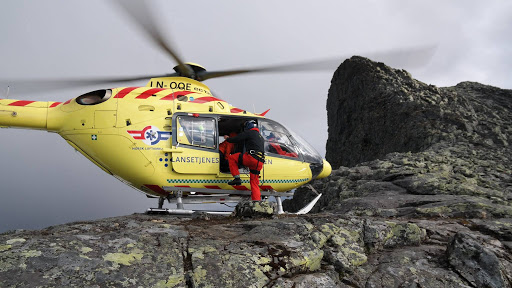
Helicopter rescue and emergency: the EASA Vade Mecum for safely managing a helicopter mission
Helicopter rescue, EASA guidance: here are the measures to be taken to safely manage emergency requests by helicopter and what certifications to apply for from EASA
Learning how to safely manage helicopter operations is crucial for frontline emergency personnel.
Helicopter rescue: when a request for help arrives, it is necessary to know how to act according to the procedures required by the operational protocol, the Mission Request Vade Mecum, published by EASA
This tool was developed for all those who, working in the safety and emergency sector, might find themselves involved in managing a helicopter mission.
Responding immediately to a request for help in a helicopter is not easy.
Normally, before leaving for a mission, personnel in the area – passers-by, people involved, the police – alert the operations room, which in turn (depending on the information received) assesses whether or not a helicopter mission is appropriate.
This is a fundamental operation; the operations room must be appropriately informed of the location of the emergency: only in this way can it examine the situation and the possible landing area of the helicopter.
The personnel involved in the incident must communicate, clearly and precisely, their location, the quality of the landing area, the weather conditions (the presence of clouds may interfere with the visibility of the incident) and the presence of obstacles and power lines in the vicinity (they must be at least 100 m away from the helicopter).
When the operations room decides to activate helicopter intervention, the pilot must be made aware of some essential information in order to reach the scene of the emergency and be able to land safely.
However, although it may seem easy in some ways, passing the correct information between the personnel involved and the operations centre is not always straightforward: emotional stress aside, the point of view of a person on the ground and one arriving from above tends to change radically.
For this reason, it is very important to have the most detailed information possible.
If this does not happen, the pilot may not find the accident site immediately and delay his intervention.
Elements that can help the pilot in identifying the site are geographic coordinates, social media (such as WhatsApp, through which the current position can be sent), reference towns, cities and roads, and the presence or absence of bridges and rivers.
THE BEST EQUIPMENT FOR HEMS OPERATIONS? VISIT THE NORTHWALL BOOTH AT EMERGENCY EXPO
Vade Mecum EASA for helicopter rescue: another important condition to emphasise is the suitability of the landing zone
It is not always the case that the accident site is suitable to host a helicopter, sometimes because the site is too small (the ideal is a space of 25×25 metres or in some cases 50×50 metres, both free of obstacles) or because it may not be safe.
However, in some cases, there may be large plots, sports fields or empty parking areas nearby where the helicopter can be safely landed.
Moreover, these locations are often closed to the public, making helicopter operations more secure.
Once the landing area has been identified, it must be suitably prepared for the helicopter.
People must remain at a distance of at least 50 metres from the helicopter, vehicles such as motorbikes and cars must be moved away to avoid damage and, should the helicopter land on or near a road, it becomes essential to block traffic.
Whenever a helicopter activity is organised, a form must be filled in, in which the main information must be entered, such as, we remind you, the type of mission, the presence of obstacles, the weather conditions and the landing area.
Certifications and homologation, the VADE MECUM EASA Helicopter Guidelines
In addition to this, to be taken into account when carrying out helicopter transports or missions are the homologation certificates.
The EASA – European Union Aviation Safety Agency – is responsible for providing the necessary certification for helicopters.
But what is type-approval?
Type-approval is the process by which it is demonstrated that a product, i.e. an aircraft, engine or propeller, meets the applicable requirements, including the provisions of Regulation (EU) 2018/1139 and its implementing rules i.e. Part 21 of Regulation (EU) 748/2012 (Subpart B) and related interpretative material (AMC & GM to part 21 – in the Initial Airworthiness section).
The application for certification must be submitted to EASA according to the instructions provided on the site on the specific page and the applicant shall pay to the Agency fees in accordance with the Commission Regulation (EU) latest amendment on fees and charges due to the Agency (EASA) available on the website of the same name.
Elilombardia, for example, has been recognised as one of the first companies in the sector eligible to operate according to EASA 965/2012 regulations, guaranteeing a standard recognised at European level for all the operational activities the company carries out.
Planning a helicopter mission is not an operation to be underestimated: there are many procedures and rules to be respected for the safety of all those involved.
VISIT THE PAGE THAT EASA HAS DEDICATED TO HELICOPTER RESCUE AND HEMS OPERATIONS
Read Also:
Emergency Live Even More…Live: Download The New Free App Of Your Newspaper For IOS And Android
When Rescue Comes From Above: What Is The Difference Between HEMS And MEDEVAC?
MEDEVAC With Italian Army Helicopters
HEMS In Russia, National Air Ambulance Service Adopts Ansat
Russia, 6,000 People Involved In The Largest Rescue And Emergency Exercise Carried Out In The Arctic
HEMS: Laser Attack On Wiltshire Air Ambulance


